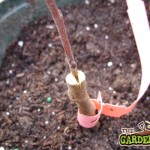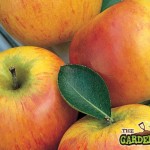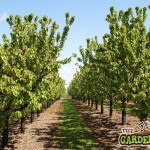Growing your own top fruits is a rewarding pastime which will reap its reward every autumn giving you a juicy crop without requiring the same intensive labour that a vegetable garden can consume. There is an endless range of apple tree varieties, both new and traditional that can be grown while adding other fruits such as cherries, plum and pear can add to your harvest. Of course orchards are not only providing you with fruit they are also attractive features in gardens with spring flowers and autumn foliage that can provide a beautiful backdrop to your garden or help to link the garden with the surrounding countryside. Orchards also increase wild life activity in the garden with bees pollinating the flowers and birds and mammals feeding on berries and fruits in autumn.
- Grafting an Apple
- Apple Coxs Orange Pippin
- Apple orhard
In general trees are low maintenance plants and can be looked after with some general care over the course of the years, but with any gardening task preparation is the key.
Before you can start planting your orchard you must first carefully consider the variety or cultivars of apples that you can or want to grow. A number of considerations must be met including the following:
- Root stock – Vigorous, semi dwarf or dwarf
- Traditional or New species
- Flowering time of trees
Firstly rootstock choice is important as the rootstock will determine the rate of growth and eventual final height of your apple tree. The rootstock is the type of root that has been grafted on to the apple tree. The reason for grafting an eating or cooking apple is to combine two trees together to give one tree with ideal fruits, disease resistant and a suitable growth rate. For example; a Golden Delicious apple tree may have tasty fruits but its root may not be suitable for damp soils and may cause the tree to grow too fast. The solution is to graft or ‘glue’ the top of the Golden delicious (called scion) to the root of another, hardier tree (called the stock).
There are several different root stock types and therefore names and luckily they all have really inventive names like those listed below!
- Vigorous: M25/ M111 Tree final tree size approx 5M
- Damp soil tolerant: M111
- Semi- Vigorous: MM106/ M116 Tree final tree size approx 4M
- Disease resistant M116
- Semi dwarf M26/ G935/G202/ G3 Tree final size approx 2M
- Dwarf M9/ M27/ G11 Trees size approx 1M
When you know the rootstock type you can determine the spacing between the trees:
The most common stock size sold in Ireland would be the Semi- vigorous 4M tall trees. Trees of this height should be spaced 3.5 to 4M apart in rows.
This spacing will allow optimum use of space without one tree shading out another.
The second consideration would be Traditional or New varieties/ cultivars.
This is a decision of individual preference; to choose traditional Irish varieties would be to sustain the heritage of Irish apples and to grow apple trees that were once common on Irish soil, are suited to Irish soil and are home to and can sustain a larger number of insects.
Choosing new cultivars (cultivar meaning manmade / cross pollinated) would give you a wider choice of apple trees that have been cross bred (not GM) to give better fruits, disease resistance and larger crops.
Some varieties to consider (Ir = Traditional Irish)
Ard Cairn Russet (Ir) – Crisp and Juicy yellow apples, resistant to scab (Venturia inequalis)
Kerry Pippin (Ir) – Small but juicy apples
Cavan Sugarcane (Ir) – Cooking Apple
The third consideration before buying your stock of trees is to be sure that they flower at the same time. This is important for pollination, which lead to the development of the fruit and therefore your harvest. To help determine which tree flower together they have been broken into 5 groups of flowering stages. Any two apples from the same group can be planted within 100M of each other to ensure pollination. The groups are:
Group 1 (can be pollinated by trees from group 1 and 2)
Irish Peach
Gibbons Russet
George Cave
George Neal
Devonshire Quarrenden
Christmas Pearmain
Vistabella
Ribston Pippin – Triploid
St Edmunds Russet
Lord Lambourne Rev. W. Wilks
Group 2 (can be pollinated by trees from group 1, 2 and 3)
Allington Pippin
Bardsey
Beauty of Bath
Beauty of Blackmoor
Bloody Butcher
Ballyvaughan Seedling
Bramley’s Seedling
Kilkenny Pearman
Cox’s Orange Pippin
Crispin
Crowngold
Discovery
Epicure
Fiesta
Royal Gala
Golden Russet
Granny Smith
Kidd’s Orange Red
Princess
Pixie
Red Devil
Winter Gem
Group 3 (can be pollinated by trees from group 2, 3 and 4)
Cornish Gillyflower
Cavan Sugarcane
Court of Wick
Greasy Pippin
Falstaff & Red Falstaff
Golden Delicious
Golden Nobel
Monarch
Pitmaston Pineapple
Red Devil
Winter Gem
Tom Putt
Group 4 (can be pollinated by trees from group 3, 4 and 5)
Ard Cairn Russet
Franks Seedling
Herrings Pippin
Tremlett’s Biter
Merton Beauty
Group 5 (can be pollinated by trees from group 4 and 5)
Edward VII
Dabinette
Crawley Beauty


